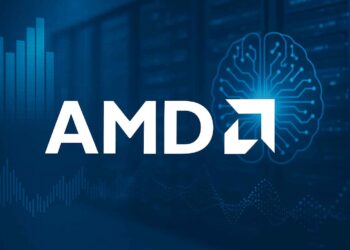U.S. stocks opened the week on a split note Monday, with the Nasdaq Composite outpacing peers on a fresh burst of AI-related deal momentum, while the Dow Jones Industrial Average lagged amid cyclical softness and renewed growth worries. The S&P 500 hovered near flat as investors weighed big-tech strength against a downbeat October read on U.S. manufacturing and the drag from a prolonged federal government shutdown threat.
Key Takeaways
- Tech leadership persists: Mega-cap names tied to AI infrastructure and cloud spend—Amazon, Microsoft, Nvidia—extended gains, helping the Nasdaq outperform.
- Macro cools: The ISM Manufacturing PMI slipped to 48.7 in October (contraction territory), reinforcing a “slow patch” narrative for goods activity.
- Rates ease: Softer manufacturing data nudged Treasury yields lower at the long end, a modest tailwind for duration-sensitive growth stocks.
- Policy overhang: With Washington gridlocked, a shutdown extending toward record territory keeps a lid on risk appetite even as earnings season surprises skew positive.
Market Snapshot
- Nasdaq Composite: Outperformed on AI momentum, cloud spend signals, and software strength.
- S&P 500: Little changed as tech gains offset weakness in industrials and select defensives.
- Dow Jones: Underperformed, pressured by cyclicals more exposed to the manufacturing downshift.
Sector tone: Tech led, while industrials and select healthcare names trailed. High-beta software and AI-adjacent plays outperformed; travel & leisure and rideshare were mixed as investors rotated toward quality growth.
What’s Driving the Tape
1) AI Investment Deals Keep the Growth Engine Humming
Fresh AI/cloud agreements and pipeline chatter stoked confidence that hyperscalers and their partners will keep capital spending elevated into 2026. That underpins demand across data center hardware (GPUs, networking) and softwarestacks, supporting earnings visibility for the AI complex. For equities, the message is simple: secular growth remains intact even as the macro wobbles.
2) Manufacturing Signals Contraction—But Not Collapse
The ISM Manufacturing PMI (48.7) marked another month below 50, signaling continued contraction. Beneath the headline, new orders and production cooled, while supplier delivery times lengthened—a reminder that tariffs and supply frictions are still filtering through. Historically, readings in the high-40s align with slower but positive overall GDP growth, not outright recession. Equity markets translated that as “bad news is (somewhat) good news” for rates-sensitive tech.
3) Rates and the Curve: A Gentle Tailwind for Growth
The post-ISM move took 10-year Treasury yields a touch lower, easing valuation pressure on longer-duration equities. The 2s/10s remained narrowly inverted, but any drift down in real yields tends to support AI leaders and quality software—the cohort already driving index-level performance.
4) Washington Watch: Shutdown Overhang
With the government shutdown edging toward record territory, markets face headline volatility around federal data releases, contractor payments, and consumer sentiment. Thus far, the bigger impact is sentiment and uncertainty, not fundamentals—but an extended disruption could spill over into spending and employment in Q4 if not resolved.
Earnings Pulse: Still Better Than Feared
The breadth of upside surprises this season—especially among tech and select consumer names—has tempered multiple compression risks. The setup into the next few weeks: AI-linked capex keeps estimate revisions resilient, while cyclical groups hinge on incremental macro clarity.
Strategy: How to Position Now
- Lean into secular growers: Stay overweight AI infrastructure and software with durable cash flows and pipeline visibility.
- Barbell with quality defensives: Pair growth exposure with high-quality staples/healthcare that can carry earnings if the goods economy stays soft.
- Selective cyclicals: Favor asset-light industrials and logistics over capital-intensive names until manufacturing stabilizes.
- Duration sensitivity: If long yields grind lower, long-duration tech and cloud software likely retain leadership.
Risks to Watch
- Policy tail risk: A protracted shutdown that disrupts household income or contracting.
- AI capex moderation: Any slowdown in hyperscaler spend would hit leadership cohorts hardest.
- Stickier inflation: A surprise re-acceleration could reprice rate expectations and compress multiples.
- Geopolitics and tariffs: Further trade frictions could prolong supplier delays and pressure margins.
Outlook
With AI momentum still the market’s center of gravity and manufacturing in a controlled contraction, equities are set up for rangebound but constructive action—tech leadership with rotational chop beneath the surface. The bull case hinges on yields easing and earnings resilience; the bear case is a policy stumble or a negative inflection in AI spend. For now, leadership breadth is narrow but intact.
Conclusion
Monday’s split tape underscores a market balancing secular AI tailwinds against cyclical softness. Until manufacturing stabilizes—or the shutdown cloud lifts—expect tech to do the heavy lifting while investors prize balance-sheet quality and durable growth. Pullbacks in leaders continue to look buyable so long as long-end yields trend lower and earnings revisions stay positive.
FAQ
What did the ISM Manufacturing PMI show for October?
It fell to 48.7, signaling continued contraction in U.S. manufacturing (sub-50).
Why did tech outperform?
Fresh AI and cloud deals reinforced expectations for robust data center and software demand, supporting mega-cap growth.
How are Treasury yields affecting stocks?
Softer manufacturing data pulled long-term yields lower, a tailwind for long-duration growth (especially large-cap tech).
Is a prolonged government shutdown a market risk?
Yes. While the immediate hit is mostly sentiment, an extended shutdown could dampen spending, delay data, and raise volatility.
What’s the near-term playbook?
Favor secular growers tied to AI, balance with quality defensives, and stay selective in cyclicals until manufacturing steadies.
Disclaimer
This article is for information and education only and does not constitute investment advice, an offer, or a solicitation to buy or sell any security. Markets involve risk, including loss of principal. Do your own research or consult a licensed financial advisor before making investment decisions. All figures referenced pertain to November 3, 2025unless stated otherwise.








